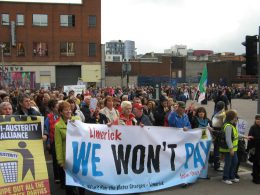The resignation of Governor of the Women’s Prison, the Dochas Centre, Kathleen McMahon at the end of April, followed by the announcement of John Lonregan, Mountjoy Governor that he is stepping down from his position has given a glimpse of the massive problems in the Irish prison service. Coupled with the Oireachtas investigation into claims of overcrowding, and degrading and inhumane conditions brought by a former member of the Mountjoy Visiting Committee, it is clear that the prison service is at breaking point, with serious implications for both staff and inmates but also for society as a whole.
Reports of prisoners sleeping in shower units and on floors with coackroachs and other vermin have been submitted to government, along with the fact that almost 100 inmates were “under protection” and violent disturbances were inherent in the situation. One third of medical services in Irish prisons are unsuitable.
The government’s “solution” – to create an extra 500 prison places and to relocate Mountjoy out to rural north county Dublin is a costly joke – designed to create the illusion of a “get tough on crime” approach, while supposedly addressing prisoner welfare issues, but the reality is that this costly debacle will only add to the problems. Families, particularly from outside Dublin will find visiting this location very difficult, adding to stress and isolation.
It is true that many of the prisons are outdated and Victorian and should be decommissioned, but this is not the root of the problem. The Dochas Centre, for example, which opened in 1999 is a very modern facility. It was supposed to be a flagship for modern prison management, improving prisoner conditions and trying to use the time in prison to rehabilitate people rather than having them constantly reoffend.
But this was consistently undermined by overcrowding. The prison was built to accommodate 85 women, it is now housing 135. The health care unit is being used to accommodate six women. Others sleep on the floor in common-rooms. This is barbaric. Placing women in bunk beds in rooms designed for one will undoubtedly increase stress and pressure and cause tension resulting in problems for the entire unit. By doing this, prison officials are planning for overcrowding into the future rather than dealing with the fact that the entire penal system needs to be reformed.
Society has to examine who is being put in prison and for what. Traditionally, the number of female prisoners in Ireland was in single figures. It is only in the past twenty years that it has become more common for custodial sentences to be handed down to women.
Most women are in prison for non-violent crime, either theft or drug related, generally guilty of crimes linked to poverty and disadvantage. Drugs are rampant in the prison, both illegal and prescribed medication. In overcrowded conditions, with widespread depression and isolation, it is absolutely disgraceful that there is not a single counsellor is available to help deal with the circumstances that gave rise to the crime or the drug taking in the first place.
Meanwhile, it has been revealed that 3,300 people were incarcerated in the first ten months of 2009, for non-payment of fines. If that rate were to be maintained, half the prison population would be incarcerated for this “crime”. With the economic crisis leaving more and more people falling behind in payments, jailing us all is hardly a solution.
It causes huge strain on the family involved, particularly if they are living far from the prison, does not sort the problem of the debt which remains unpaid and costs the state €93,000 a year for the privilege of keeping a person in prison. Even on economic grounds, this does not make sense. Non-payment of debt or fines should not result in a custodial sentence.
Similarly, tackling the reasons why people take drugs and assisting them to get clean has to be prioritised. A revolving door, with the same people reoffending demonstrates graphically that the system isn’t working. There must be a massive investment in drug support treatment, counselling and psychiatric support and education, both in the prisons but also when someone is released.
It is well known that the prison population is directly linked to social disadvantage with 146 prisoners for every 10,000 people in the most deprived areas, compared to 6 in the least deprived.
Investing in education, social services and jobs, not more prison places, will make society a safer and better place for all.











